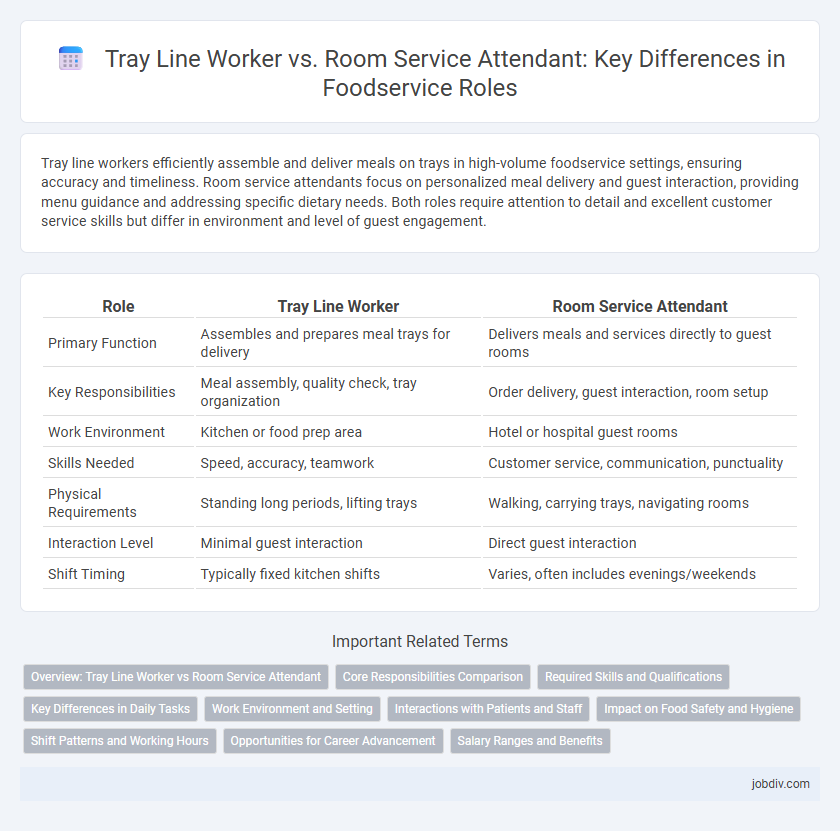Tray line workers efficiently assemble and deliver meals on trays in high-volume foodservice settings, ensuring accuracy and timeliness. Room service attendants focus on personalized meal delivery and guest interaction, providing menu guidance and addressing specific dietary needs. Both roles require attention to detail and excellent customer service skills but differ in environment and level of guest engagement.
Table of Comparison
| Role | Tray Line Worker | Room Service Attendant |
|---|---|---|
| Primary Function | Assembles and prepares meal trays for delivery | Delivers meals and services directly to guest rooms |
| Key Responsibilities | Meal assembly, quality check, tray organization | Order delivery, guest interaction, room setup |
| Work Environment | Kitchen or food prep area | Hotel or hospital guest rooms |
| Skills Needed | Speed, accuracy, teamwork | Customer service, communication, punctuality |
| Physical Requirements | Standing long periods, lifting trays | Walking, carrying trays, navigating rooms |
| Interaction Level | Minimal guest interaction | Direct guest interaction |
| Shift Timing | Typically fixed kitchen shifts | Varies, often includes evenings/weekends |
Overview: Tray Line Worker vs Room Service Attendant
Tray Line Workers specialize in efficiently assembling and organizing food trays in high-volume foodservice settings, ensuring speedy meal distribution for institutions like hospitals and cafeterias. Room Service Attendants focus on delivering meals directly to guests' rooms, providing personalized service and handling special requests in hotels or healthcare facilities. Both roles require attention to detail and adherence to food safety standards but differ primarily in their interaction with customers and service environment.
Core Responsibilities Comparison
Tray Line Workers specialize in assembling and distributing meal trays efficiently while adhering to dietary guidelines and ensuring accurate meal orders. Room Service Attendants focus on delivering personalized food and beverage orders directly to guest rooms, maintaining high customer service standards and handling special requests. Both roles require attention to detail and adherence to hygiene standards but differ in task execution and guest interaction level.
Required Skills and Qualifications
Tray Line Workers require strong organizational skills, the ability to work efficiently under pressure, and attention to detail for assembling and distributing meals accurately. Room Service Attendants must possess excellent customer service skills, effective communication abilities, and knowledge of hospitality protocols to deliver personalized dining experiences. Both roles demand physical stamina and basic food safety certifications to maintain hygiene standards in foodservice environments.
Key Differences in Daily Tasks
Tray Line Workers primarily focus on assembling and organizing meals efficiently on trays for quick distribution in foodservice environments, ensuring accuracy and timely delivery. Room Service Attendants specialize in delivering food directly to guests' rooms, providing personalized service and handling guest requests or dietary modifications. The key difference lies in the Tray Line Worker's production-oriented role versus the Room Service Attendant's guest-centric service and communication responsibilities.
Work Environment and Setting
Tray Line Workers typically operate in fast-paced, high-volume settings such as hospitals or large cafeterias where efficiency and speed are crucial for delivering meals along assembly lines. Room Service Attendants work in quieter, personalized environments like hotels or healthcare facilities, delivering food directly to guests' or patients' rooms while maintaining customer engagement and attention to detail. Both roles require strong organizational skills, but Tray Line Workers focus more on repetitive, coordinated tasks, whereas Room Service Attendants emphasize hospitality and individual service.
Interactions with Patients and Staff
Tray Line Workers primarily interact with kitchen staff to ensure timely meal preparation and assembly, focusing on efficient service rather than direct patient engagement. Room Service Attendants engage directly with patients, addressing specific dietary needs and preferences while coordinating with nursing and dietary departments to deliver personalized meal experiences. Both roles require collaboration with clinical and foodservice teams to maintain patient satisfaction and operational flow within healthcare settings.
Impact on Food Safety and Hygiene
Tray Line Workers play a crucial role in maintaining food safety and hygiene by consistently following sanitation protocols during meal assembly, ensuring contamination risks are minimized. Room Service Attendants contribute to food safety by carefully handling and delivering meals in a clean environment, preventing cross-contamination and maintaining temperature control. Both positions require strict adherence to hygiene standards to protect consumers and uphold regulatory compliance in foodservice operations.
Shift Patterns and Working Hours
Tray Line Workers typically operate on fixed, extended shifts ranging from 8 to 12 hours, often covering peak meal times in foodservice operations. Room Service Attendants usually have more flexible or rotating shifts, including evenings and weekends, aligning with guest demand patterns. Both roles require adaptability to varying hours, but Tray Line Workers follow more structured schedules compared to the dynamic shifts of Room Service Attendants.
Opportunities for Career Advancement
Tray Line Workers gain foundational skills in food handling and assembly, often progressing to supervisory roles or quality control positions within the foodservice industry. Room Service Attendants develop customer service expertise and time management abilities, creating pathways to guest relations, hospitality management, or concierge roles in hotel foodservice departments. Both roles offer distinct career advancement opportunities by leveraging operational experience and interpersonal skills essential for leadership positions.
Salary Ranges and Benefits
Tray Line Workers in foodservice typically earn hourly wages ranging from $12 to $16, with benefits including basic health insurance and meal discounts. Room Service Attendants often receive slightly higher pay, between $14 and $18 per hour, along with tips, health benefits, and potential for shift differentials. Both roles may offer paid time off and employee discounts, but Room Service Attendants generally enjoy greater earning potential due to gratuities and added responsibilities.
Tray Line Worker vs Room Service Attendant Infographic

 jobdiv.com
jobdiv.com